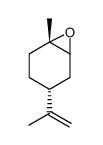(+)-Trans-limonene1,2-epoxide

(+)-Trans-limonene1,2-epoxide structure
|
Common Name | (+)-Trans-limonene1,2-epoxide | ||
|---|---|---|---|---|
| CAS Number | 6909-30-4 | Molecular Weight | 152.23300 | |
| Density | 0.930 g/mL at 20ºC(lit.) | Boiling Point | N/A | |
| Molecular Formula | C10H16O | Melting Point | N/A | |
| MSDS | USA | Flash Point | 65ºC | |
|
Catalytic mechanism of limonene epoxide hydrolase, a theoretical study.
J. Am. Chem. Soc. 127(41) , 14339-47, (2005) The catalytic mechanism of limonene epoxide hydrolase (LEH) was investigated theoretically using the density functional theory method B3LYP. LEH is part of a novel limonene degradation pathway found in Rhodococcus erythropolis DCL14, where it catalyzes the hy... |
|
|
QM/MM study of the mechanism of enzymatic limonene 1,2-epoxide hydrolysis.
Biochim. Biophys. Acta 1824(2) , 263-8, (2012) Limonene 1,2-epoxide hydrolase (LEH) is completely different from those of classic epoxide hydrolases (EHs) which catalyze the hydrolysis of epoxides to vicinal diols. A novel concerted general acid catalysis step involving the Asp101-Arg99-Asp132 triad is pr... |
|
|
Total synthesis of (+)-cymbodiacetal: a re-evaluation of the biomimetic route.
J. Org. Chem. 75(24) , 8465-70, (2010) A total synthesis of (+)-cymbodiacetal (1) has been completed from (R)-(+)-limonene oxide using a hetero-Diels-Alder cycloaddition as a key step. The key Diels-Alder cycloaddition proceeds with endo-selectivity (2:1, endo/exo) in quantitative yield, and the t... |
|
|
Metabolism of limonene-1,2-epoxide in the rat.
Xenobiotica 10(12) , 859-61, (1980) 1. The metabolism of limonene-1,2-epoxide was studied following intraperitoneal injection in rats and in rat liver homogenates. 2. Limonene-1,2-glycol was the only neutral metabolite detected. Major limonene metabolites, p-mentha-2,8-dien-1-alpha and -beta-ol... |
|
|
Indoloquinazoline alkaloids from Euodia rutaecarpa and their cytotoxic activities.
J. Asian Nat. Prod. Res. 13(11) , 977-83, (2011) Nine indoloquinazoline alkaloids (1-9) were isolated from the dried and nearly ripe fruits of Euodia rutaecarpa (Juss.) Benth. (Euodiae Fructus), along with limonin and β-sitosterol. Their structures were elucidated on the basis of their spectroscopic data. A... |
|
|
The structures of alpha 2u-globulin and its complex with a hyaline droplet inducer.
Acta Crystallogr. D Biol. Crystallogr. 55(Pt 4) , 753-62, (1999) Alpha 2u-globulin (A2U) is the major urinary protein excreted by adult male rats. The structure of a monoclinic crystal form of A2U was reported in 1992 [Böcskei et al. (1992). Nature (London), 360, 186-188]. The structures of an orthorhombic crystal form of ... |
|
|
Limonene-1,2-epoxide hydrolase from Rhodococcus erythropolis DCL14 belongs to a novel class of epoxide hydrolases.
J. Bacteriol. 180(19) , 5052-7, (1998) An epoxide hydrolase from Rhodococcus erythropolis DCL14 catalyzes the hydrolysis of limonene-1,2-epoxide to limonene-1,2-diol. The enzyme is induced when R. erythropolis is grown on monoterpenes, reflecting its role in the limonene degradation pathway of thi... |
|
|
Alternating copolymerization of limonene oxide and carbon dioxide.
J. Am. Chem. Soc. 126(37) , 11404-5, (2004) The alternating copolymerization of (R)- or (S)-limonene oxide and CO2 using beta-diiminate zinc acetate catalysts is reported. At 100 psi CO2 and 25 degrees C, the catalyst exhibits a high selectivity for the trans isomer and produces regioregular polycarbon... |
|
|
Acaricidal activity of limonene, limonene oxide and beta-amino alcohol derivatives on Rhipicephalus (Boophilus) microplus.
Vet. Parasitol. 157(1-2) , 149-53, (2008) Limonene, limonene oxide and eight beta-amino alcohol derivatives obtained by synthesis were investigated for the effect on egg hatchability and mortality rates of newly hatched larvae of the cattle tick Rhipicephalus (Boophilus) microplus. At the doses betwe... |
|
|
Lysosomal degradation of alpha 2u-globulin and alpha 2u-globulin-xenobiotic conjugates.
Toxicol. Appl. Pharmacol. 103(3) , 539-48, (1990) A diverse group of chemicals cause a male rat-specific nephrotoxicity in which alpha 2u-globulin accumulates in renal lysosomes. It has been suggested that these chemicals bind to the protein and decrease its degradation by lysosomal proteinases. To test this... |